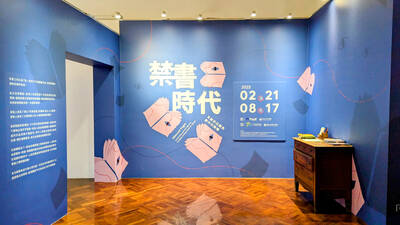He wowed New York with huge man-made waterfalls, drew the masses to London’s Tate Modern with a giant artificial sun and is now staging his first major solo show in his adopted city, Berlin.
Icelandic-Danish artist Olafur Eliasson, 43, is widely considered one of contemporary culture’s most ambitious creators, using ingenious tricks to offer urban dwellers a new perspective on the space in which they live.
The exhibition, Inner City Out, opens today at the Martin Gropius Bau museum, next to one of the longest remnants of the Berlin Wall.
Using light, shadows, color, fog, mirrors and the movements of the exhibition’s visitors to create their effects, the 19 installations explore Eliasson’s relationship with the city where he has lived and worked since 1994.
“I first came to Berlin shortly before the Wall fell” in 1989, Eliasson told reporters. When he returned, he said the city itself quickly became
his muse.
“The unpredictability at the time was very inspiring. It became a place where I could establish myself with my work.”
Since then, he has become one of the hottest draws on the international museum circuit with major shows in Tokyo and London.
The 2003-2004 Weather Project at the Tate Modern’s cavernous Turbine Hall invited visitors to interact with each other in the shadow of the “half-sun,” with many banding together to create giant figures on the floor which were reflected in mirrors on the ceiling.
Two years ago, Eliasson built a spectacular open-air installation of huge waterfalls along the East River, which became a major draw for tourists and New Yorkers alike.
The German title of the Berlin show, Innen Stadt Aussen, is a play on words, meaning literally Inside City Outside but phonetically can be understood to mean inside instead of outside.
Museum director Joachim Sartorius called it “the most beautiful, most poetic exhibition” he was putting on this year. He declined to discuss the cost of the show, which was three years in the making, but called it “expensive.”
Access to the first room is gained via a recreation of a Berlin sidewalk with its distinctive granite slabs.
It leads to a series of rooms adorned with curvaceous, cracked mirrors, colored projectors and sculpted mobiles that play with the light and the movement of visitors to great effect as they slowly rotate.
The show wraps up in a disorienting room full of fog, leaving visitors groping for the walls to orient themselves as only pastel-colored lights mark off three sections of the opaque space.
And beyond the museum walls, Eliasson has dispersed throughout the city large pieces of driftwood that washed onto the Icelandic coastline after epic journeys from Siberia and the Americas. Many of the logs have already been snapped up
by collectors.
Born in Copenhagen to Icelandic parents, Eliasson was raised in Denmark and Iceland — he is a dual citizen — and divides his time between Berlin and his native city.
Asked about the possible artistic implications of Iceland’s Eyjafjallajokull volcano erupting, which brought European air traffic to a halt this month, Eliasson described the phenomenon as “very, very beautiful.”
“It produces this unbelievable bass tone,” he said.

There is a Chinese Communist Party (CCP) plot to put millions at the mercy of the CCP using just released AI technology. This isn’t being overly dramatic. The speed at which AI is improving is exponential as AI improves itself, and we are unprepared for this because we have never experienced anything like this before. For example, a few months ago music videos made on home computers began appearing with AI-generated people and scenes in them that were pretty impressive, but the people would sprout extra arms and fingers, food would inexplicably fly off plates into mouths and text on

On the final approach to Lanshan Workstation (嵐山工作站), logging trains crossed one last gully over a dramatic double bridge, taking the left line to enter the locomotive shed or the right line to continue straight through, heading deeper into the Central Mountains. Today, hikers have to scramble down a steep slope into this gully and pass underneath the rails, still hanging eerily in the air even after the bridge’s supports collapsed long ago. It is the final — but not the most dangerous — challenge of a tough two-day hike in. Back when logging was still underway, it was a quick,

From censoring “poisonous books” to banning “poisonous languages,” the Chinese Nationalist Party (KMT) tried hard to stamp out anything that might conflict with its agenda during its almost 40 years of martial law. To mark 228 Peace Memorial Day, which commemorates the anti-government uprising in 1947, which was violently suppressed, I visited two exhibitions detailing censorship in Taiwan: “Silenced Pages” (禁書時代) at the National 228 Memorial Museum and “Mandarin Monopoly?!” (請說國語) at the National Human Rights Museum. In both cases, the authorities framed their targets as “evils that would threaten social mores, national stability and their anti-communist cause, justifying their actions

In the run-up to World War II, Admiral Wilhelm Canaris, head of Abwehr, Nazi Germany’s military intelligence service, began to fear that Hitler would launch a war Germany could not win. Deeply disappointed by the sell-out of the Munich Agreement in 1938, Canaris conducted several clandestine operations that were aimed at getting the UK to wake up, invest in defense and actively support the nations Hitler planned to invade. For example, the “Dutch war scare” of January 1939 saw fake intelligence leaked to the British that suggested that Germany was planning to invade the Netherlands in February and acquire airfields